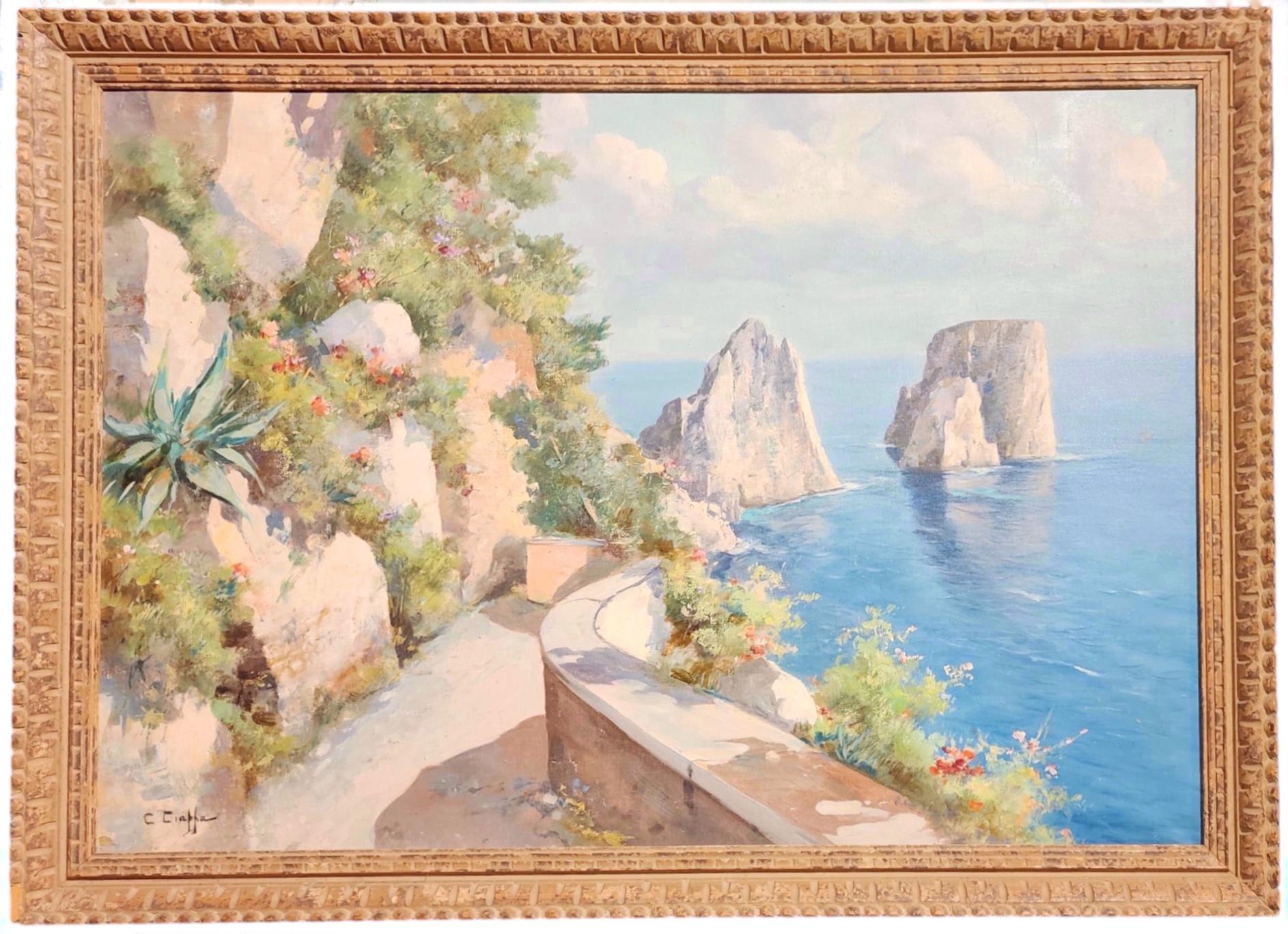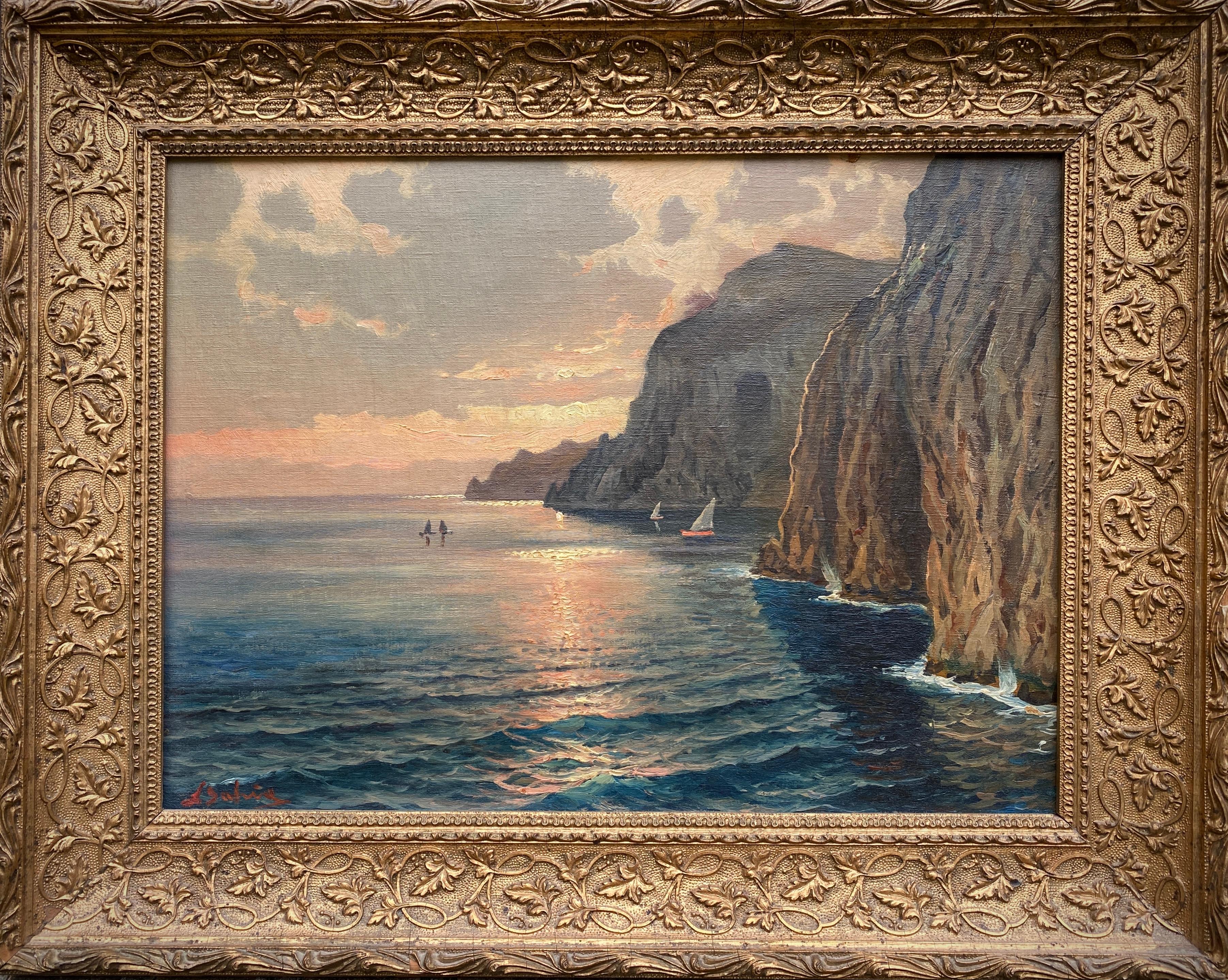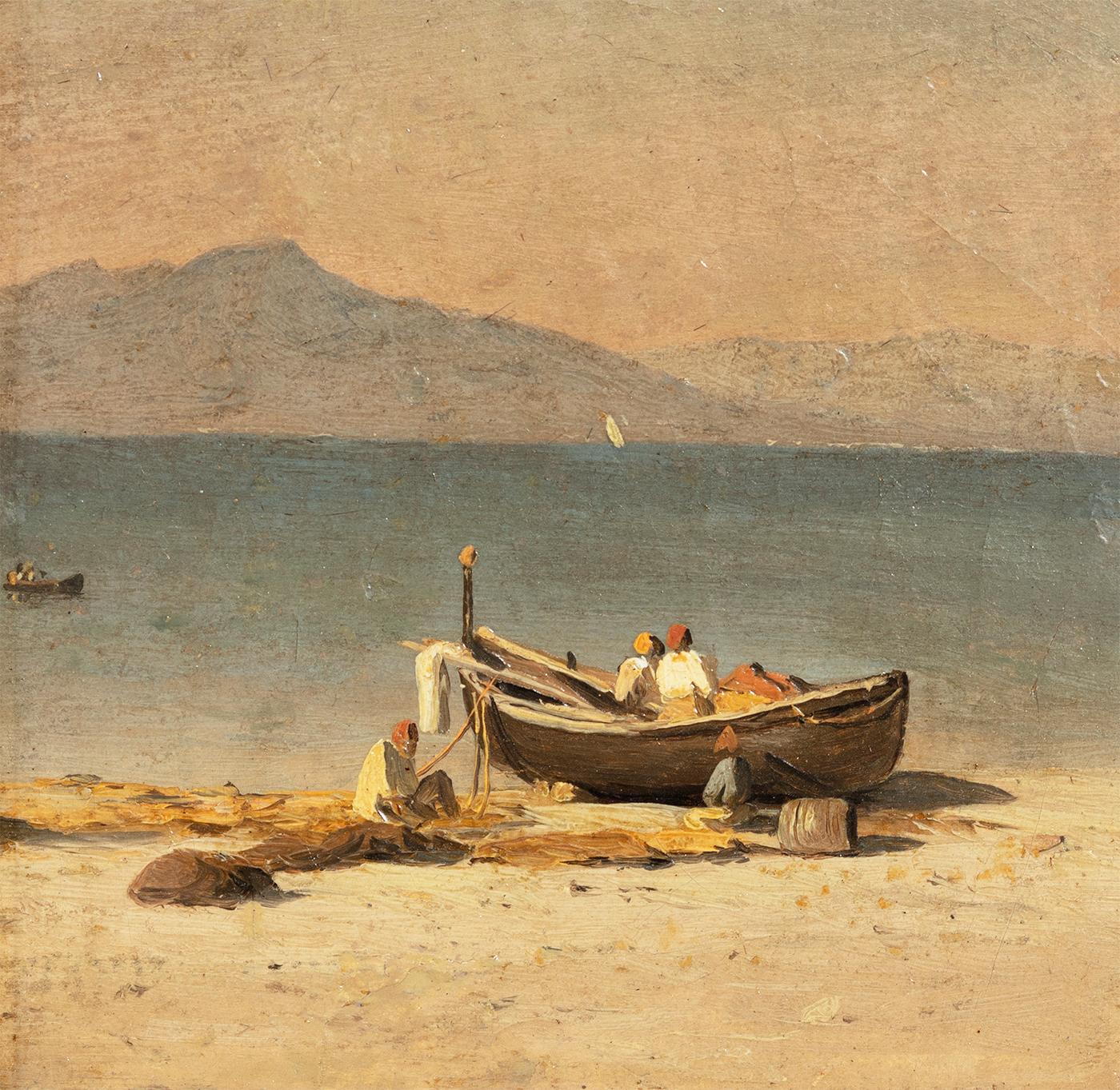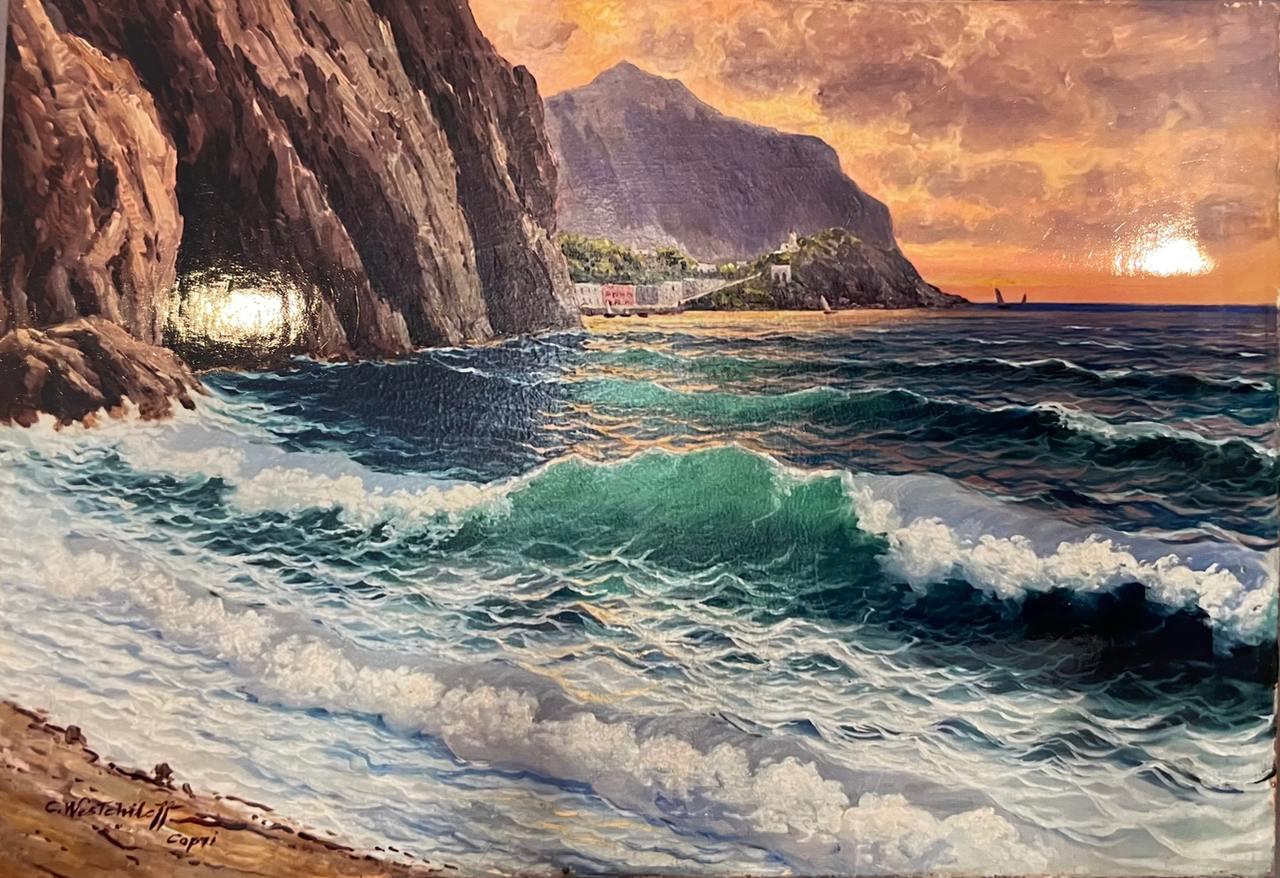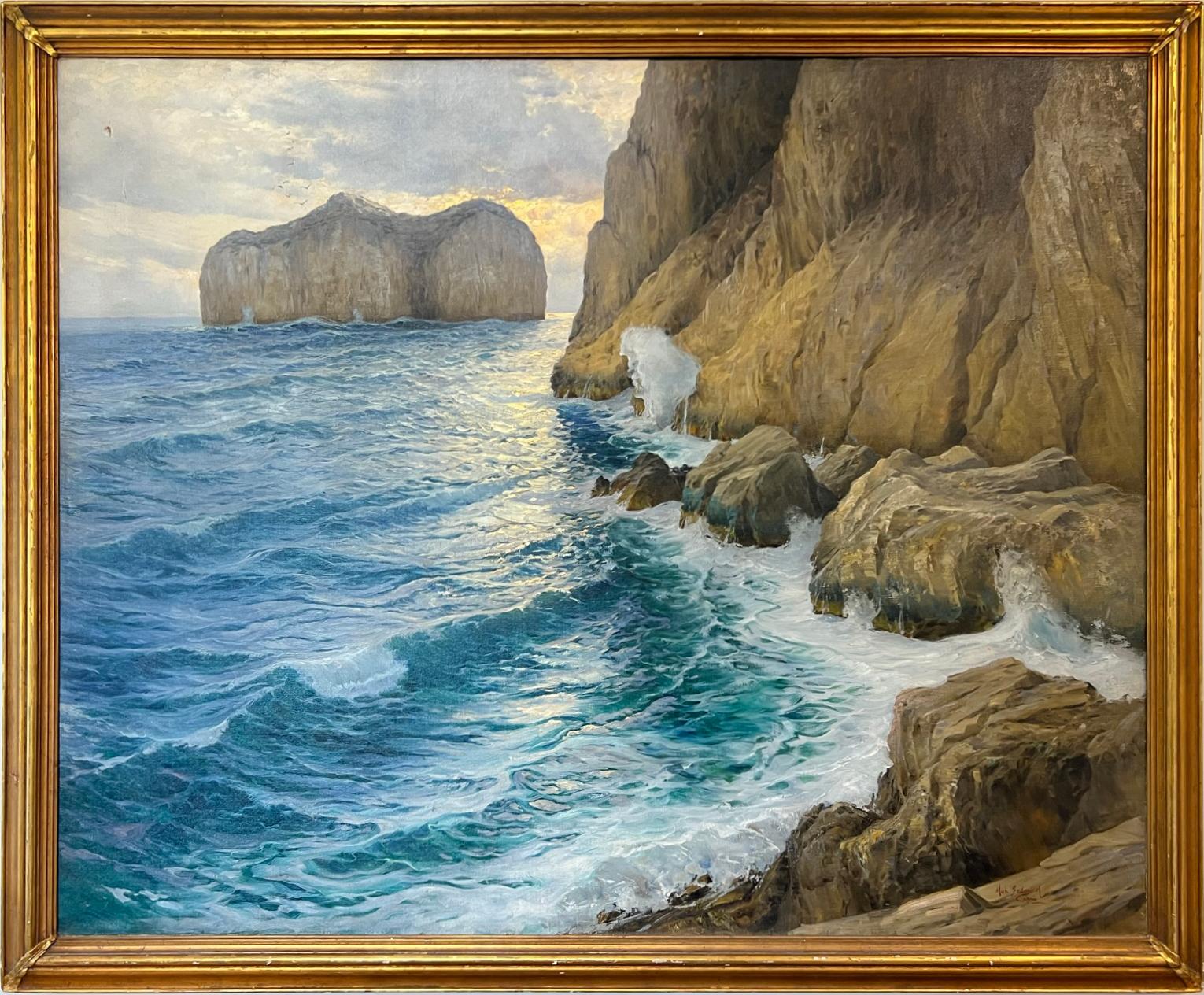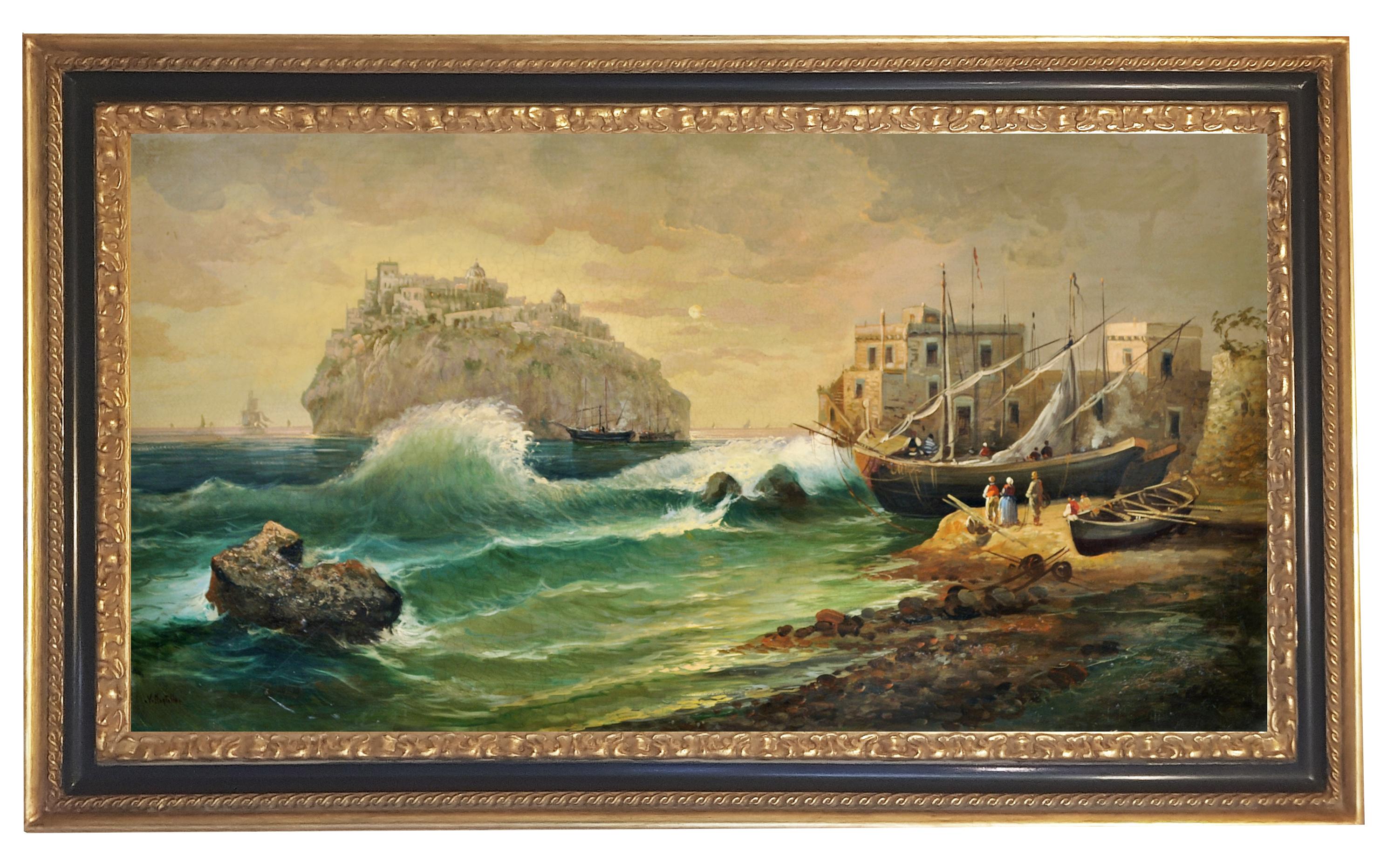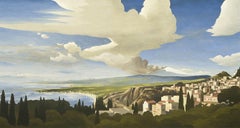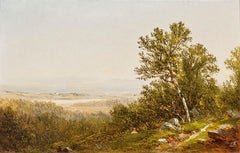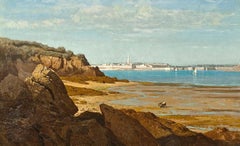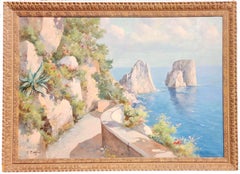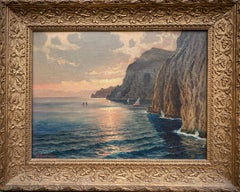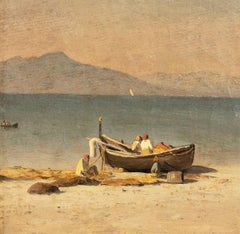Items Similar to Marina Grande, Capri
Want more images or videos?
Request additional images or videos from the seller
1 of 8
Charles Temple DixMarina Grande, Capri1866
1866
$150,000
£113,291.45
€130,931.43
CA$210,397.95
A$233,982.90
CHF 122,479.25
MX$2,854,306.80
NOK 1,538,996.40
SEK 1,447,624.80
DKK 977,318.10
About the Item
Charles Temple Dix was born in Albany, New York, the youngest son of the distinguished statesman and soldier, General John Adams Dix. Having already visited Europe as a child, Dix returned with his family to Italy from 1853 to 1855. Dix’s decision to become an artist was enthusiastically supported by his father, and after graduation from Union College, Schenectady, New York, Dix continued his art studies in New York City in the late 1850s. Dix quickly immersed himself in the New York art world. He occupied a studio at the famous Tenth Street Studio building from 1860 to 1862, and he exhibited annually at the National Academy of Design, New York, from 1857 to 1861, the year in which he was elected an associate of that institution. He never submitted the diploma painting required for qualification as a full member.
Following the outbreak of the Civil War, Dix joined the Union army, serving as a major and acting as his father’s aide-de-camp. His creative output during this period was curtailed by his involvement in wartime activities. In March 1865, at the close of the war, Dix resumed his artistic career. He left for Europe, spending the winter in Rome and visiting England sometime thereafter. It appears that he remained for at least some time, for in 1867 he exhibited at the Royal Academy, London. In 1868, he married Camilla Ottilie Watson, niece of the art historian, Mrs. Anne Brownell Jameson, in London, and the married couple soon settled in Rome. In January 1873, Dix joined other American artists in Rome in signing a resolution mourning the death of the much-admired Hudson River School painter, John F. Kensett. Dix’s brief period in Rome ended two months later, when he died at the age of thirty-five of a sudden hemorrhage of the lungs.
In the course of his short and promising career, Dix had established himself as a popular and successful painter of marine subjects, and he was one of the few such painters to elicit praise regularly from contemporary critics. In his Book of the Artists (1867), Henry Tuckerman called Dix a painter “of rare promise and no inconsiderable performance in the sphere of marine landscape” (p. 552), an unfortunately ironic forecast of the artist’s brief career.
Beginning about 1866, when he first wintered in Rome, Dix painted a number of marine subjects of the island of Capri. The present picture dates from that winter, before Dix’s trip to England and his subsequent marriage and relocation to Rome. Dix evidently traveled to the island, returning to Rome with sketches of its coastal scenery. Located on the northern side of the island, the Marina Grande was the chief port on Capri. Dix frames the composition at right with the large, rocky cliffs characteristic of Capri’s coastline, while the sweep of the water opens to the left. Dix’s use of color is deep and clear, faithfully capturing the incomparable range of blues of the Mediterranean sea and sky. All of the elements of the picture—rocks, clouds, boats, and water—are treated with careful accuracy, reflecting a truth-to-nature aesthetic as espoused by the influential English critic, John Ruskin, and echoing similar concerns with the rocky coast landscape as fellow American marine artist, William Stanley Haseltine. Marina Grande, Capri is remarkable in that the artist was only twenty-eight years old when he painted it, and it leads one to speculate as to what Dix might have accomplished had he enjoyed a longer life and career.
- Creator:Charles Temple Dix (1838 - 1873, American)
- Creation Year:1866
- Dimensions:Height: 18.25 in (46.36 cm)Width: 30.25 in (76.84 cm)
- Medium:
- Movement & Style:
- Period:
- Condition:
- Gallery Location:New York, NY
- Reference Number:Seller: APG 8206.011stDibs: LU234159111
About the Seller
5.0
Recognized Seller
These prestigious sellers are industry leaders and represent the highest echelon for item quality and design.
Established in 1952
1stDibs seller since 2010
35 sales on 1stDibs
Typical response time: 3 hours
Associations
Art Dealers Association of America
- ShippingRetrieving quote...Shipping from: New York, NY
- Return Policy
Authenticity Guarantee
In the unlikely event there’s an issue with an item’s authenticity, contact us within 1 year for a full refund. DetailsMoney-Back Guarantee
If your item is not as described, is damaged in transit, or does not arrive, contact us within 7 days for a full refund. Details24-Hour Cancellation
You have a 24-hour grace period in which to reconsider your purchase, with no questions asked.Vetted Professional Sellers
Our world-class sellers must adhere to strict standards for service and quality, maintaining the integrity of our listings.Price-Match Guarantee
If you find that a seller listed the same item for a lower price elsewhere, we’ll match it.Trusted Global Delivery
Our best-in-class carrier network provides specialized shipping options worldwide, including custom delivery.More From This Seller
View AllMt. Etna from Taormina
By Thomas Fransioli
Located in New York, NY
Thomas Fransioli, born in 1906 in Seattle, Washington, trained as an architect at the University of Pennsylvania. He worked as an architect before his service in World War II. Largel...
Category
20th Century American Realist Landscape Paintings
Materials
Canvas, Oil
Fishing Camp on the Labrador Coast
By William Bradford
Located in New York, NY
In 1852, twenty-nine year old William Bradford was a failing shopkeeper in Fairhaven, Massachusetts. With a wife and child at home, Bradford, by his own admission, “spent too much time in painting to succeed” in business. Rescued from insolvency by his well-to-do in-laws, this is not the beginning of a narrative that generally leads to a happy ending. Not so with Bradford, who ultimately found international fame and fortune as a painter of arctic seascapes and dramatic marine paintings.
William Bradford, the artist, was a lineal descendant of the 17th-century Separatist leader William Bradford, a founder of the Plymouth Plantation, signer of the Mayflower Compact and Governor of the Plymouth Colony. Our Bradford born to a New Bedford ship outfitter in Fairhaven, Massachusetts By the nineteenth century, this line of Bradfords were Quakers, living on the tract purchased nearly two centuries earlier by their pilgrim ancestor. Fairhaven, across the mouth of the Acushnet River from the whaling center of New Bedford was described by a New York journalist in 1857 as “the Brooklyn of New Bedford” (Home Journal, January 3, 1857). Young Bradford displayed an early predilection for the arts, but his Quaker parents were disinclined to support this particular pursuit. After working in his father’s business and then for a dry goods merchant in New Bedford, by 1849 Bradford had set up in New Bedford as a “merchant tailor” offering outfits for “those going to California,” “seamen’s clothing,” custom-tailored “piece goods...
Category
19th Century American Realist Landscape Paintings
Materials
Canvas, Paper, Oil
Figure in a Landscape
By David Johnson
Located in New York, NY
Signed (at lower right): DJ [monogram]; (on back): David Johnson 1865
Category
Mid-19th Century American Realist Landscape Paintings
Materials
Oil, Board
Saint-Malo, Brittany
By William Stanley Haseltine
Located in New York, NY
The career of William Stanley Haseltine spans the entire second half of the nineteenth century. During these years he witnessed the growth and decline of American landscape painting, the new concept of plein-air painting practiced by the Barbizon artists, and the revolutionary techniques of the French Impressionists, all of which had profound effects on the development of painting in the western world. Haseltine remained open to these new developments, selecting aspects of each and assimilating them into his work. What remained constant was his love of nature and his skill at rendering exactly what he saw. His views, at once precise and poetic, are, in effect, portraits of the many places he visited and the landscapes he loved.
Haseltine was born in Philadelphia, the son of a prosperous businessman. In 1850, at the age of fifteen, he began his art studies with Paul Weber, a German artist who had settled in Philadelphia two years earlier. From Weber, Haseltine learned about Romanticism and the meticulous draftsmanship that characterized the German School. At the same time, Haseltine enrolled at the University of Pennsylvania, and took sketching trips around the Pennsylvania countryside, exploring areas along the Delaware and Susquehanna rivers. Following his sophomore year, Haseltine transferred to Harvard University.
After graduating from Harvard in 1854, Haseltine returned to Philadelphia and resumed his studies with Weber. Although Weber encouraged Haseltine to continue his training in Europe, the elder Haseltine was reluctant to encourage his son to pursue a career as an artist. During the next year, Haseltine took various sketching trips along the Hudson River and produced a number of pictures, some of which were exhibited at the Pennsylvania Academy of the Fine Arts in the spring of 1855. Ultimately, having convinced his father that he should be allowed to study in Europe, Haseltine accompanied Weber to Düsseldorf.
The Düsseldorf Academy was, during the 1850s, at the peak of its popularity among American artists. The Academy’s strict course of study emphasized the importance of accurate draftsmanship and a strong sense of professionalism. Landscape painting was the dominant department at the Düsseldorf Academy during this period, and the most famous landscape painter there was Andreas Achenbach, under whom Haseltine studied. Achenbach’s realistic style stressed close observation of form and detail, and reinforced much of what Haseltine had already learned. His Düsseldorf training remained an important influence on him for the rest of his life.
At Düsseldorf, Haseltine became friendly with other American artists studying there, especially Emanuel Leutze, Worthington Whittredge, and Albert Bierstadt. They were constant companions, and in the spring and summer months took sketching trips together. In the summer of 1856 the group took a tour of the Rhine, Ahr, and Nahe valleys, continuing through the Swiss alps and over the Saint Gotthard Pass into northern Italy. The following summer Haseltine, Whittredge, and the painter John Irving returned to Switzerland and Italy, and this time continued on to Rome.
Rome was a fertile ground for artists at mid-century. When Haseltine arrived in the fall of 1857, the American sculptors Harriet Hosmer, Chauncey B. Ives, Joseph Mozier, William Henry Rinehart...
Category
19th Century American Realist Landscape Paintings
Materials
Canvas, Oil
Italian Garden in Acadia
By John Moore
Located in New York, NY
Signed (at lower right): MOORE
Category
2010s Contemporary Landscape Paintings
Materials
Oil
Venice
By Jane Peterson
Located in New York, NY
Singed (at lower left): Jane Peterson
Category
Early 20th Century American Impressionist Landscape Drawings and Waterco...
Materials
Gouache
$60,000
You May Also Like
Road Around Capri, Tyrrhenian Sea, Italian Landscape, Island, Campania Region
Located in Grand Rapids, MI
Carlo Ciappa (Italian, 1890-1970)
Signed: A. Ciappa (Lower, Left)
" Road Around Capri ", circa 1960s
Oil on Canvas
23 1/2" x 34
Overall Size: 27" x 37"
Category
Mid-20th Century Realist Landscape Paintings
Materials
Canvas, Oil
View of Capri, Artist 20th century, European School
Located in Knokke, BE
Artist 20th century
European School
20th century
View of Capri
Signature: Signed bottom left, illegible signature
Medium: Oil on canvas
Dimensions: Image size 30 x 40 cm, frame size...
Category
20th Century Impressionist Landscape Paintings
Materials
Canvas, Oil
Marina Grande, Capri, with Figures
By Sanford Robinson Gifford
Located in New York, NY
Prominent Luminist Hudson River School painter.
Category
19th Century Hudson River School Paintings
Materials
Oil
"Capri"
Located in Edinburgh, GB
signed lower left
Category
20th Century Impressionist Landscape Paintings
Materials
Canvas, Oil
MONUMENTAL Impressionist Seascape of CAPRI, IT
By Cavalier Michele Federico
Located in New York, NY
Original Monumental oil painting by Italian artist Cavalier Michele Federico (1884–1966) of a Capri coastline. This stunningly executed Italian coastline painting...
Category
Mid-20th Century Impressionist Landscape Paintings
Materials
Oil
ISCHIA -Posillipo School - Italian Landscape Oil on Canvas Painting
By Vincenzo Montella
Located in Napoli, IT
Ischia - Vincenzo Montella Italia 2008 - Oil on canvas cm. 50x100
V. Montella's painting depicts a perspective of the island of Ischia, muse of many artists over the centuries. Artists who have been undoubtedly fascinated by our land, creating marvellous works of art. Such as Oswald Achenbach...
Category
Early 2000s Italian School Landscape Paintings
Materials
Canvas, Oil
